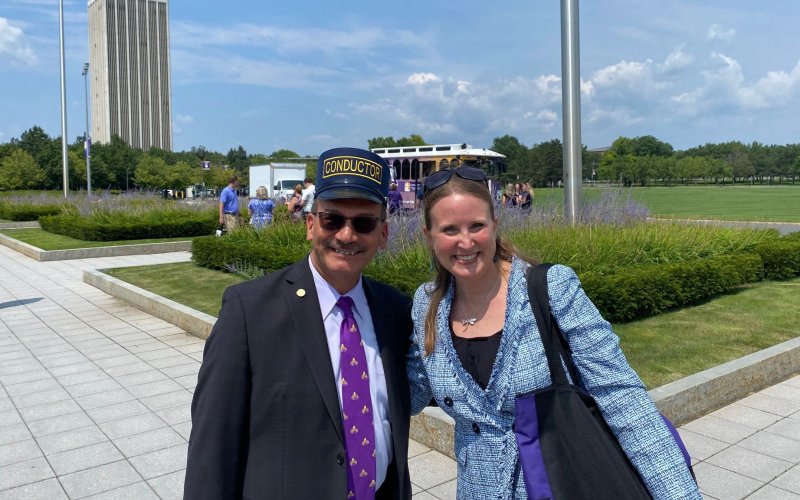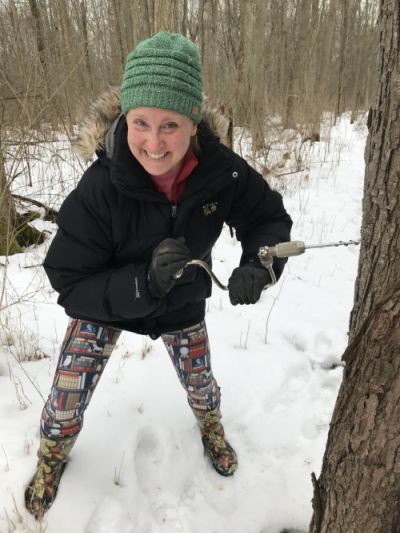Five Questions with Jessica Castner

ALBANY, NY (Aug. 29, 2023) — This fall marks the inaugural semester of the University at Albany School of Public Health’s (SPH) new nursing programs, which include a Bachelor of Science in Nursing completion program, as well as a Master of Science in Population Health Nursing.
To lead these programs, UAlbany welcomes Jessica Castner, director of nursing and professor at SPH.
Castner is an international expert in emergency nursing and comes to UAlbany following a yearlong appointment as the Distinguished Nurse Scholar in Residence at the National Academy of Medicine, where she developed health policy related to climate change and disasters, environmental health, clinician wellbeing and applications of artificial intelligence in health care.
A board-certified emergency nurse and asthma educator, Castner has spearheaded initiatives to elevate women in science, advance diversity and inclusion in nursing, and enhance trauma-informed cultural competence. Castner served as editor-in-chief of the Journal of Emergency Nursing and has published extensively on research topics centered on environmental health, health policy, health professions leadership, emergentology and public health nursing.
What inspired you to enter the field of nursing and focus on emergency care?
As a small child, the nurses I had the privilege to encounter left me with the impression they were penultimate professional archetypes. They consistently seemed so knowledgeable and compassionate, with technical skills that were deeply respected and valued in my childhood community.
My family routinely traveled 150 miles to the University of Michigan so one of my siblings could receive specialty care, so I became acutely aware of healthcare provider shortages, barriers to care access and burdens for rural communities at an early age. In my preteen years, my maternal grandmother died due to a medical device malfunction. Her death and suffering cemented my commitment to serve to improve public health and healthcare for other people’s beloved elders. In this way, my career choice was my determination to remake a tragedy into a love story. I loved science and math in school, and how nursing applied this knowledge for the greater good.
When I was in high school, my father’s employer was going through several rounds of major job cuts and layoffs. In small towns, there aren’t often many career options when an anchor employer cuts jobs, so it was a time of uncertainty for our family’s financial well-being and ability to commit to supporting my upcoming college expenses. The nursing discipline has many accessible pathways to enter the profession, from starting a part-time technical program towards licensed practical nursing (LPN) to going straight through to a university graduate degree. This flexible entry into nursing was attractive as it offered a resilient, realistic and achievable goal.
I became an emergency nurse after working as a visiting nurse case manager and cardiac telemetry/intermediate intensive care nurse. I felt my skills and abilities were of most value in emergency care, as this setting truly is our nation’s public health safety net. I love emergency nursing because of the autonomy, variety of rapid cognitive problem-solving, interdisciplinary teamwork and advanced technical skillset.
Being an emergency nurse requires a special responsibility for continuous lifelong learning and rapid skill acquisition. It never gets old, and you encounter new patient problems every day. There were a few times when my timely decisions and actions were the only thing standing between my patient and impending death or permanent disability. As an emergency nurse, you don’t really think about it in those terms in the moment. You just do your job as you are well trained to do. But when I think back, I am awestruck at the level of intensity and responsibility in emergency nursing. It’s pretty thrilling!
What drew you to UAlbany, and what are you most excited about in your new role as director of nursing?
After an appointment in the nation’s capital at the National Academies where I served as a scientific advisor to inform health policy at the federal level, I was drawn to the opportunity to continue this important public health impact here in New York State’s capital. In the U.S., we invest heavily in and pay a huge price tag for disease and injury care and yet, we are woefully unhealthy compared to our global peers. Across history, these are the kinds of challenging times when innovative nursing solutions emerge to transform public health — solutions like visiting nurses, trauma care systems, pregnancy and perinatal care, school-based clinics, telephone triage, immunization outreach programs and more.
The origin story and strategic partnership that UAlbany’s School of Public Health enjoys with the New York State Department of Health is unlike any other program I’ve known in the country, if not the world. I’m thrilled to pioneer a program where the nursing discipline can strategically align and benefit from this unique and important foundation for public health.
I’m also honored to be counted as part of one of the nation’s most diverse public research institutions, with health sciences and minority health disparities among its signature research strengths. Here at UAlbany, we are well positioned to offer nurses a very exciting and unique learning experience supported by a rich array of resources, from the brilliant research-intensive university resources to several high-quality healthcare systems and agencies. We have so much to offer our students!
On a personal level, I was drawn to UAlbany as we have kinship ties and a family heritage and history that includes deep roots in the Albany area, reaching back in time to long before this place was even named Albany or New York. It is deeply meaningful to reflect on how we are a result of centuries of their love, dreams, work and sacrifices. This is a beautiful and special region — for its culture, people and career opportunities. I’m also the proud and grateful parent of a UAlbany alum.
How do research experiences – like those offered through UAlbany’s BSN completion and MSN programs – enrich nurses’ practice in a clinical setting?
Research experiences place you in a learning environment among some of the most brilliant minds our educational system has to offer, so we can put our heads together about ways to improve care and public health. Research helps refine how to think as a change agent and innovator, two things that nurses tend to be very good at! It places you on the cutting edge of new innovations and ideas. All of this translates into a better end result of nursing practice — lowering public health mortality, disease burden and health care costs while improving quality of life.
In hospital nursing, there is a special designation by the American Nurse Credentialing Center called "Magnet" recognition for workplaces that excel in attracting and retaining their professional nursing workforce. One of the five key components of these types of organizations is nurses’ contribution to new knowledge, innovations and improvements. Here, we see the profound value of research that creates healthier, more successful clinical nursing work environments.
There is also an important individual developmental path a lot of nurses take as we move from clinical novice to expert that can focus us on technical skills, time management and critical thinking about the individual patient or family first. We all evaluate and use research evidence in each phase of our nursing practice.

Over time, many of us inevitably start asking questions like: Why are we all doing this practice out of habit, training or hospital/agency requirements, when it doesn’t seem to be making a difference for patients or public health? Would this new idea for an intervention work better? Can we make a device to solve this particular clinical problem? What if the public could access a software application to address this need? And so on. We are so fortunate as a research-intensive university here at UAlbany to have the resources for nursing students to be able to ask these questions, gather and analyze data and share their findings to improve nursing practice, patient outcomes and public health.
How does the ‘BSN in 10 Law’ benefit nurses?
If you are a registered professional nurse (RN) licensed to practice in New York State, this law means that you must successfully complete your BS degree in Nursing within 10 years of receiving your first RN license. We know that education is a powerful driver of personal health, wealth, well-being, leadership and career opportunities across the span of one’s life. Not only does advancing education help the individual nurse, it helps their patients, too. Research shows that if you are a patient, the proportion of nurses on the team caring for you with a bachelor’s in nursing or higher impacts the quality of care you receive and, ultimately, your health outcomes as well.
Many employers and governments are now offering funding (like grants, loan repayment, tuition reimbursement and scholarships) for nurses to go back to school in nursing as a workforce recruitment and retention strategy, which is another key employee benefit for nurses. The BSN in 10 Law promises to benefit nurses personally, the care quality for the patients they serve and often, even their employer’s investment in retaining them.
What do you enjoy doing in your spare time?
I enjoy time with my loved ones, athletic activities and lifelong learning. Every year, I set a goal to learn three new skills or hobbies, so I am often a student in the classroom myself! The most enduring spare time activities I’ve kept up over the years have been heritage oral histories and storytelling, swimming, jogging, kayaking, bicycling, reading, sewing and carpentry.




